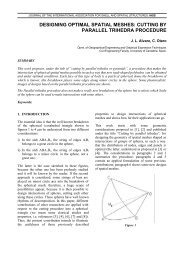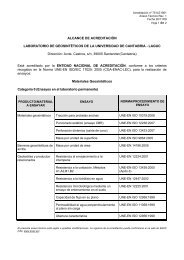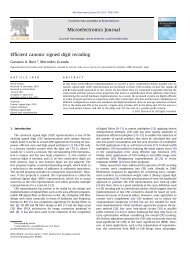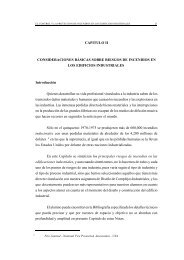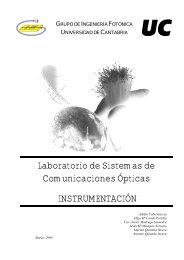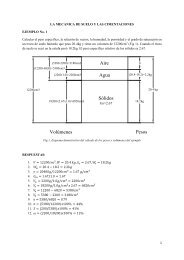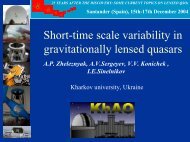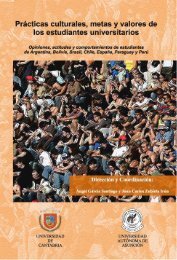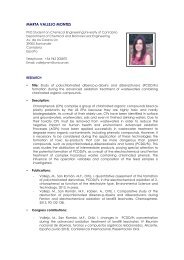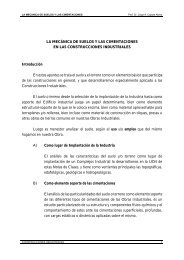37º IAHS World Congress on Housing: - Universidad de Cantabria
37º IAHS World Congress on Housing: - Universidad de Cantabria
37º IAHS World Congress on Housing: - Universidad de Cantabria
- No tags were found...
Create successful ePaper yourself
Turn your PDF publications into a flip-book with our unique Google optimized e-Paper software.
XXXVII <str<strong>on</strong>g>IAHS</str<strong>on</strong>g><str<strong>on</strong>g>World</str<strong>on</strong>g> <str<strong>on</strong>g>C<strong>on</strong>gress</str<strong>on</strong>g> <strong>on</strong> <strong>Housing</strong>October 26 – 29, 2010, Santan<strong>de</strong>r, SpainCODE: 609LIVING THE HISTORIC CITY: UNIVERSALACCESSIBILITY AND ENERGY EFFICIENCY STRATEGIESEgusquiza A., Gandini A.Department of Cultural Heritage. Tecnalia C<strong>on</strong>structi<strong>on</strong>e-mail: aegusquiza@labein.es, agandini@labein.esKey words: historic cities, energy efficiency, universal accessibilityAbstractIn or<strong>de</strong>r to protect our urban historic heritage we must focus <strong>on</strong> protecting not <strong>on</strong>ly thephysical fabric but also the social c<strong>on</strong>text, recognizing the right of local resi<strong>de</strong>nts to c<strong>on</strong>tinueliving in the area. Labein-Tecnalia <strong>de</strong>velops a research line based <strong>on</strong> the belief thatfurthermore ensuring the maintenance of historic buildings, urban policies should aim atimproving quality of life in historic centres, facilitating the sustainable <strong>de</strong>velopment andintegrating citizens’ participati<strong>on</strong> into planning processes. C<strong>on</strong>sistent with this i<strong>de</strong>al, thiswork points at recommending universal accessibility and energy efficiency strategies for thehistoric city. One of the projects related to energy efficiency is the SECHURBA projectwhich aims to <strong>de</strong>m<strong>on</strong>strate sustainable energy interventi<strong>on</strong>s in historic urban areas andbuildings, respecting culture, heritage and local character. The project addresses localcommunities with their barriers and potentialities by <strong>de</strong>veloping best-practice technicalmethods, innovative tools and bottom-up “Community Climate Change Strategies”, as atransferable technical toolkit and an innovative Intelligent Energy Applicati<strong>on</strong> Tool forrelevant key actors. Furthermore, the E2CH project arises from the c<strong>on</strong>cept that historicalcities could be handled as a reference mo<strong>de</strong>l for c<strong>on</strong>temporary urban <strong>de</strong>velopment. One of itsmain goals is to improve knowledge of energy performances within the historic centre as asystem, studying the efficiency and adaptability of traditi<strong>on</strong>al buildings to the envir<strong>on</strong>ment.The project will <strong>de</strong>velop a comprehensive methodology and different tools for the diagnosis,the <strong>de</strong>cisi<strong>on</strong> making, the implementati<strong>on</strong> of soluti<strong>on</strong>s and the subsequent management ofenergy at urban-scale. Another factor that influences the habitability of the historic city is thelack of universal accessibility. The main goal of the PATRAC project is to provi<strong>de</strong> a <strong>de</strong>cisi<strong>on</strong>support system for planning improvements in accessibility ensuring that the optimal soluti<strong>on</strong>is adopted according to criteria of universal access, respecting cultural values and ec<strong>on</strong>omicviability.37º <str<strong>on</strong>g>IAHS</str<strong>on</strong>g> <str<strong>on</strong>g>World</str<strong>on</strong>g> <str<strong>on</strong>g>C<strong>on</strong>gress</str<strong>on</strong>g> On <strong>Housing</strong> Science 238



